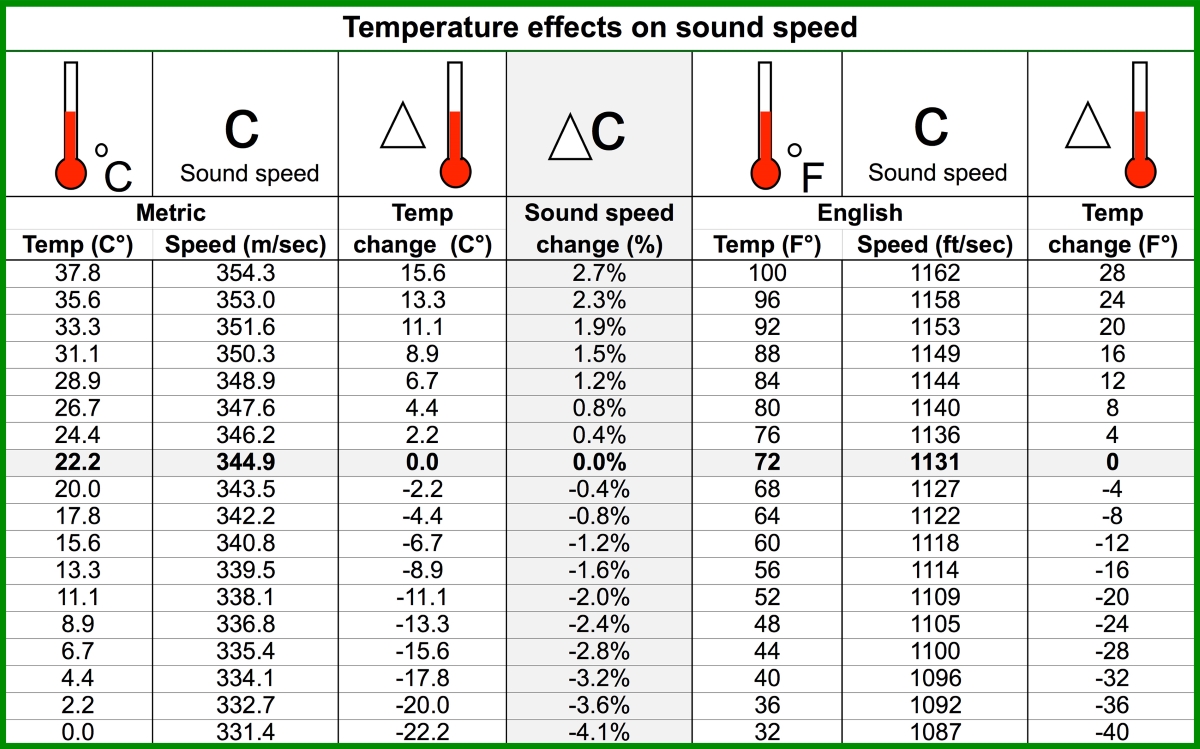
Q: What’s the speed of sound?
You’ve probably memorized 1,132 feet (344 meters) per second, along with an added temperature variable. But it turns out that visualizing fractions of 1,132 (or 344) is challenging to put to practical use with sound designs. How would you like a speedometer calibrated to seconds per mile?
We can ease things by turning the sound speed equation inside-out and rescaling it into units that can be visualized: milliseconds (ms) per foot or meter. A rough approximation is 1ms/ft, but we can get a lot closer with 0.9ms/ft. So 10 feet is 9 ms or 10 ms is 11 feet. The metric version is really easy (surprise!) because the rough measure (3ms/meter) is almost exactly the actual one (2.94 ms/meter). And here are two additional helpers that work in both the metric and imperial systems: look at the seating chart and calculate 3 ms/row (front to back) and 1.5 ms/seat (side to side).
Q: How do temperature and humidity impact sound transmission?
Temperature is a finely tuned sound speed control (Figure 3). Rising temperature increases the speed (and vice versa) by approximately 1 percent for every 10 degrees (F) and 5.6 degrees (C).

Humidity is basically a variable level very high frequency (VHF) filter. Air (at any humidity) is an imperfect medium for audio transmission: it is lossy in the highest frequency range and essentially looks like a low-pass filter that rolls out the uppermost frequencies (Figure 4). Wet air has the least amount of VHF loss while dry air has the most. The losses accumulate over distance. So a small outdoor venue in the Amazon will have much better VHF transmission than a football stadium in the desert.

How much do we need to factor the weather report into tuning the system for tonight’s show? A good sound design in the sunshine will still be good when it’s cloudy, and a bad one will not be fixed by better weather.
Yes, it’s true that delay settings will wander out of calibration as the temperature changes, the severity of which varies with venue size. A huge temperature shift of 20 degrees (F) would introduce errors of less than 2 percent. This could move things out of calibration by 1-2 ms (concert hall), 2-4 ms (arena) or 4-8 ms (stadium), respectively. I doubt this will be a game changer.
Humidity change is easy to adapt to. Listen up. Boost up the VHF range if it’s dry (and sounds dark) and dial it down if it’s wet (and sounds bright). All of the action is up there in the VHF region, so as long as you confine changes to that region, you’re OK.
Q: What’s the difference between sound pressure level (SPL) and acoustic power?
It’s easy to mistakenly equate the two. The “P” in dB SPL is pressure, a vital component in acoustic power but not the whole thing. It helps to think of electrical power.
Voltage is present at the wall outlet, but no power is actually generated until you stick your finger into it and current flows. A loudspeaker is an acoustic power generator, measurable in acoustic watts (converted from electrical watts). A microphone does the opposite.
We could measure 100 dB SPL generated from a loudspeaker that travels 10 meters to a mic diaphragm. The pressure created by the loudspeaker and sensed by the mic is the same, but the amount of acoustic power involved in this matter is worlds apart. The speaker has spread a sound pressure of 100 dB over a 10-meter spherical surface area (which takes massive acoustic power). The mic diaphragm’s surface area is less than 1 inch across (which takes miniscule acoustic power to move).
Recall Ohm’s law, which shows how electrical power is derived from the relationships of voltage, resistance and current. Acoustic power has analogous properties for these: voltage (sound pressure), resistance (acoustic resistance, inertance) and current (surface area). Acoustic propagation is a series of pressure variations traveling spherically through a resistive medium such as air. The surface area of the pressure variations expands as the sound propagates outward. The acoustic power stays constant as sound propagates outward (except for frictional losses).
In other words, a loudspeaker that generates 1 watt at 1 meter also generates 1 watt at 2 meters (neglecting friction). The reduction in pressure of 6 dB (1/2) is proportional to the expansion in surface area (2x). Acoustic power is the product of pressure and surface area (just as electrical power is the product of volts and amperes). We can have 10 volts at 1 amp or 1 volt at 10 amps and still generate 10 watts. Acoustic power over distance has the analogous behavior.
So why is it that we’ve never seen a specification for acoustic power on anything we bring to a gig? If you’re just a listener, you need only be concerned with SPL (pressure) rather than power, since the diaphragms in your ears have a very small surface area.
Therefore our experience of sound level is effectively as acoustic pressure sensors (rather than power sensors). Nonetheless, if we’re planning to deliver high levels of acoustic pressure to ears across an arena, we’d better have devices that can generate some serious acoustic power.
